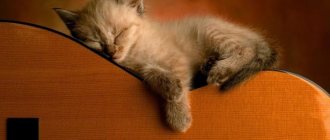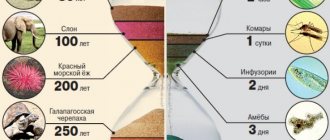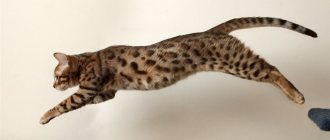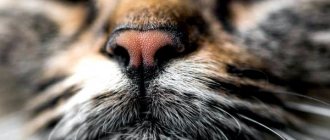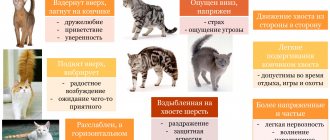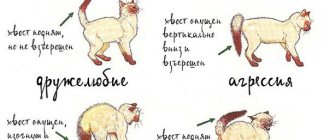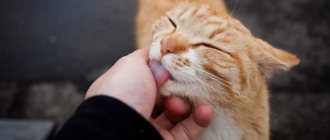Oddly enough, cats are quite emotional creatures, although they do not demonstrate their feelings as clearly as, for example, dogs. Sometimes owners face difficulties in knowing how their pet is feeling at the moment. Does he want to play or is it better not to touch the cat at the moment?
To solve this problem, you will need to be more observant and learn about some of the features of cat body language. When you learn to recognize your pet's facial expressions, you will easily determine the cat's mood and achieve complete mutual understanding with it.
Raised
A cat’s raised tail, sometimes slightly curved at the end, is a sign of the so-called “greeting”.
Very often demonstrated by pets when meeting people they know, in whose company the animal feels confident and calm. We can say that in this way cats, as far as possible, depict the joy of meeting and interacting with a person.
The animal makes contact willingly, experiencing positive emotions and a friendly attitude. Probably counting on some kind of response from the person addressed to him. For example, waiting for a treat or game.
Why you shouldn't pull your pet's tail
The cat should not be pulled by the thin tail vertebrae. According to popular belief, the pet will begin to defecate in the wrong corners. In reality, these actions are cruel, physically unpleasant for the animal, cause discomfort, and often cause injury and illness.
A bully, grabbing a cat wagging its tail, can injure the vertebrae, requiring surgical assistance or amputation.
Often hooligan actions lead to paralysis of the hind limbs and urinary incontinence in the pet.
Cats are vengeful, tugging and squeezing - which means humiliation of dignity - does not forgive, they begin to take revenge.
Fluffy
A sign of fear, restlessness and anxiety in cats is a fluffy tail, slightly raised relative to the body. The raised fur is a signal to the enemy that the animal can and is ready, if necessary, to stand up for itself.
The cat involuntarily, feeling a sense of danger or anticipating an attack in its direction, tries to visually make itself larger and larger in size in the eyes of its opponent in order to prevent a possible attack by the enemy.
If the animal continues to feel threatened, its state, depending on its own temperament and the actions of the opponent, literally in a few moments can transform into either a desire to run away from danger and hide, or into the need to attack first.
How to tell a cat's mood by its face
According to felinologists, experts in the field of keeping cats, the expression of an animal’s face can tell a lot about emotions.
Depending on the mood of the pet, the gaze and position of the ears may be different.
Developing mindfulness: how to increase attractiveness according to science
Mini braids: quick simple hairstyles for a walk or remote work
And a little geometry: fresh spring manicure ideas with the main colors of the year
- Calm state - the ears are in a vertical position, the gaze is relaxed and calm.
- Wants to play - eyes wide open, ears raised up.
- Angry and angry - ears are turned back, pupils are narrowed.
- Satisfied and, in principle, enjoying life - the eyes are slightly closed, the muscles on the face are relaxed.
- Aggressive - eyes wide open, pupils dilated, ears pressed to the head.
Now, when communicating with your pet, you will always know what mood he is in and when he should not be disturbed.
Horizontally mounted
A cat experiencing ambiguous sensations, in a state of tension and increased concentration, straightens the body of its body as much as possible, moving its tail back. The slightly twitching tip of a cat's tail, which is in line with the animal's body, betrays its anxiety and self-doubt.
The pet is confused and is not yet able to assess the surrounding situation. However, this will take him no more than a few seconds. Perhaps he will react quite unexpectedly, sharply and not always favorably for the person.
To avoid this, the owner must immediately try to show his disposition and sympathy for the animal, convincing him of the harmlessness of his intentions.
With soft intonation, an insinuating, calm voice and smooth movements, you can relax and distract your pet, letting him know that there is no source of any threat nearby.
How to understand a cat by its tail
When people talk about body language, they mean hand movements, human facial expressions and eye expressions. If we talk about animals, the most important point is the movements that are made by the tail. With dogs everything is more clear, but cats are mysterious and ambiguous creatures. How to understand a cat by its tail ?
How does a cat's tail work?
In animals, the tail continues the spine. By checking the anatomical description, you can find out that there are three parts to it: the base, the stem and the tip. On average, the length of a cat’s tail is 25 centimeters, and in males this parameter is slightly longer – 28 centimeters. The Guinness Book of Records contains an entry about the domestic cat with the longest tail in the world - its length is 41.5 centimeters.
The tail can contain a different number of vertebrae, this depends on its length - from 19 to 28. The vertebrae are oval in shape, they are connected by cartilaginous tissue and have a muscular entanglement. In the center of the vertebra there is an opening through which the spinal cord canal passes. There are 5-7 vertebrae at the tip of the tail, the latter may be pointed or underdeveloped.
Thickened cartilages located between the vertebrae allow a cat's tail to be very flexible. In the intervertebral cavities there is a plexus of nerve endings. You don't need to be a veterinarian to know that a cat's tail is sensitive.
Why does a cat need a tail?
The tail is a very important component of the body of both wild and domestic cats:
- You can use your tail to maintain balance. Cats are capable of climbing on a variety of surfaces; they can climb onto a balcony, roof, tree, jump from dizzying heights and even fall. During flight, a cat moves all parts of its body, especially its tail, so it can almost always land on all four limbs. Such abilities give the animal the opportunity to fall not only from the not very high second and third floors, but also from the fifth, sixth and higher. With all this, the flight will not end in tragedy, but in a completely successful and safe outcome. Thanks to their own tail, cats can not only jump wonderfully, but also land correctly on the ground. With its help, they are able to move along very narrow cornices and branches, maintaining the necessary balance;
- steering wheel. This part of the body functions as a rudder when the animal runs. It can turn sharply to the side, change its trajectory, and the tail is responsible for shifting the center of gravity. This plays an important role in the hunting process. Wild cats, such as lions, tigers, panthers and others, have very long and thick tails, and this is not without reason. Animals actively use it for chasing and jumping;
- thermoregulation. In hot weather, you can often see a cat lying in the shade and lazily wagging its tail. So she tries to cool her body by controlling air flow. In cold weather, pets tend to curl up into a ball, minimizing heat loss. They wrap their tail around the body and then stick their muzzle into it. This is how a cat uses its fur coat to warm the areas most sensitive to cold - its nose and paws.
Slow movement
A slow swaying of the tail from side to side, a narrowed gaze, smooth movements of the body, alternating with the complete freezing of the animal, signals that the pet is extremely irritated and is clearly unpleasant about what is happening around it.
The reason for such an emotional reaction in a cat can be loud sounds, unpleasant movements or touches from a person.
Cat body language
The cat arched her back and raised her tail - she was frightened by the situation, she was thinking about running away or staying for protection. When meeting other cats, this position can scare them and prevent a collision.
The cat rubs its head, butts, and moves its paws - a sign of a special predisposition towards the owner. If she allows herself to blink in the presence of her owner, sleeps next to him on her back, with her stomach exposed, her most vulnerable spot, then she trusts him infinitely.
The animal stares at a person or another cat with a frozen gaze, on alert - it waits and is ready to attack at the slightest threat.
The most correct answer to how to determine a cat’s mood can only be by combining all of the above symptoms. The cat is a very harmonious animal; it cannot react to what is happening only with its tail or movement of its head.
Curved Down
An arched and downward-curved cat's tail, resembling an inverted "U", indicates that the animal is preparing to take a defensive position.
If at the same time the cat begins to move smoothly, semi-sideways towards the source of visible danger, you should know that the defensive stance and state of tension will quickly turn into defensive aggression, and the temperamental animal may well suddenly begin to attack.
Tail
Watching cats, many get the impression that their tail is a truly unique organ that seems to live its own life. Even if the animal’s body is motionless, the tail can “write out” the most unimaginable pretzels, by which it will be possible to guess the pet’s mood.
A tail that is in a calm state, lowered down and parallel to the ground, indicates a neutral mood. If he rises sharply, remaining in the “pipe” position, this is a clear sign of a friendly mood or joy when the owner appears. When watching potential prey or interesting events, cats show special curiosity and enthusiasm, and the tip of the tail trembles slightly at such moments. Sharp movements from side to side indicate a playful and even gambling mood of the animal. And the smoother ones are about concentrated observation of something. When a cat is irritated and dissatisfied with something, it sharply wags its tail, the tip of which is curved. A state of the highest degree of rage, aggression or external threat will help to recognize a vertically raised, fluffy tail.
How to tell if your cat is getting old
Rhythmic blows to the sides
Sharp, nervous twitching of the tail from side to side indicates that the cat is experiencing severe irritation.
This is a kind of warning that if the source of negativity does not leave the animal’s personal space in the near future, the pet will be forced to strike a warning blow.
The cat is not aggressive and does not really want to attack the enemy at the moment. But circumstances leave him no choice, because he is seriously puzzled by the issue of eliminating the source of irritation that is bothering him.
If a cat butts its head
If your pet bangs its head against you, as if trying to butt you, this is an expression of sympathy for the owner. This is how the cat demonstrates its trust or expresses gratitude, for example, for a delicious dinner.
Do cats do this in the evenings when you return home after a day of work? They thereby ask for affection. Surely your tailed friend has already gotten bored and in his sign language demands your attention, wants to be petted.
Some experts believe that cats mark their territory in this way. On the forehead, lips and chin, as well as on the tail and paw pads, cats have glands that secrete special pheromones. When a cat rubs against its owners, or, for example, against the furniture that surrounds it, it thereby puts a mark on them. Subsequently, by smell it will not be difficult for her to distinguish her own from the “strangers”.
